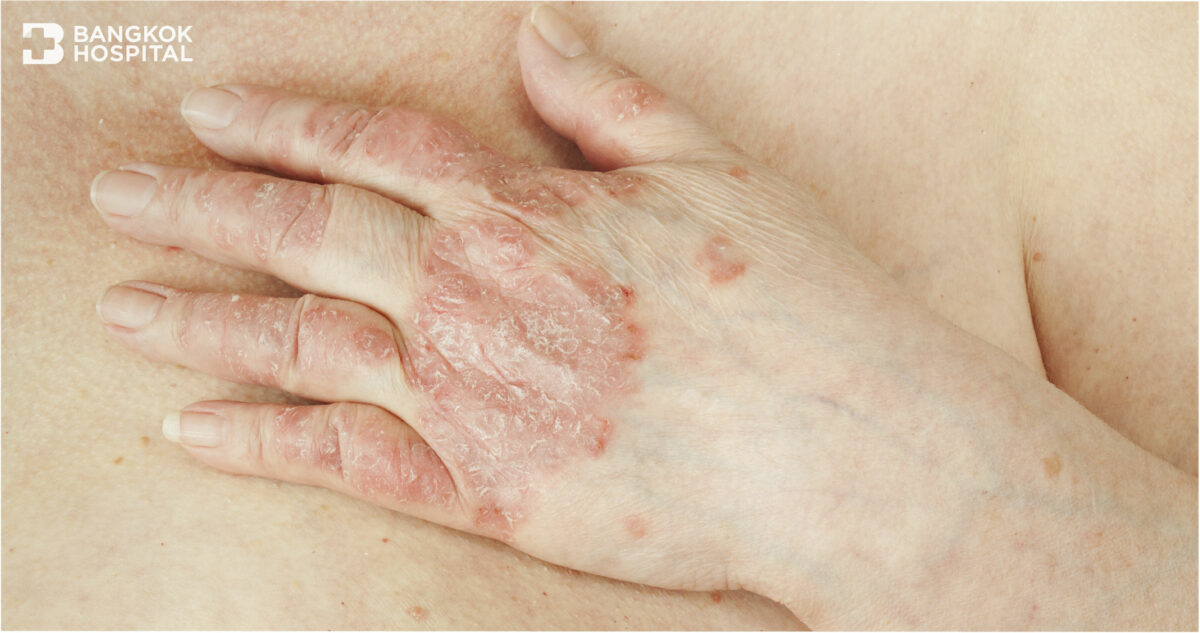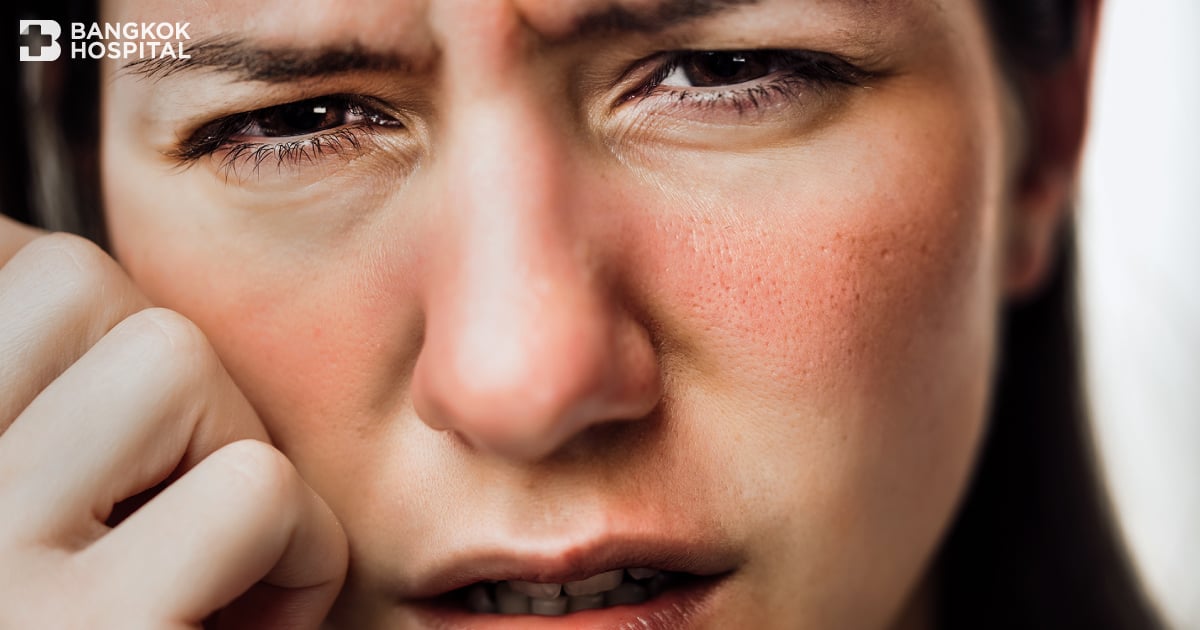Chronic arthritis is a category of diseases that can cause disability, and among the different types of arthritis there is one that afflicts many young adults. It is a type of arthritis that usually strikes the bones in the spine and nearby joints. This is known medically as “spondyloarthropathy.”
Why Spinal Arthritis is Dangerous.
- According to statistics, spondyloarthropathy patients account for about 1-2% of the Thai population. This amounts to more or less one million people, which is quite significant.
- Spondyloarthropathy often occurs in young people, from adolescence to working youthful adults who are the future of the country. This has depleted a group of our nation’s important productive resources.
- Their symptoms are not predominant, and that is why many general practice doctors often overlook or are unfamiliar with the signs. Consequently, this group of patients are not diagnosed sufficiently early nor receiving timely treatment. In some cases, they have to endure the pain for a long time or until they become disabled before getting the right care.
- The severity of this category of diseases differs for each patient. For some it appears to be mild, while for others it can be severe. Patients need experienced doctor to provide appropriate treatment and care, which must be adjusted to meet each patient’s symptoms along with close monitoring. Since Spondyloarthropathy is a chronic condition and requires a long-term treatment, patients should seek to consult an experienced specialist such as doctors in the field of rheumatology.
Which Diseases are in Spondyloarthropathy Group?
This group of diseases is called joint and spinal arthritis due to its symptoms, which usually strike around a joint in the arm and leg – such as knee and ankle. It also causes swelling and inflammation of the spine, leading to backaches and pains; though some patients may not experience any discomfort at all. There are many diseases in this group that currently cannot be clearly distinguished, such as:
- Ankylosing Spondylitis, a type of arthritis that mainly causes inflammation in the spine and possibly in the leg and arm joints also.
- Psoriatic Arthritis, a type of arthritis generally affecting people who have psoriasis condition.
- Reactive Arthritis, joint inflammation caused by an infection in another part of the body.
- Inflammatory Bowel Disease, which in this country is not frequently found without any indicator from other diseases.
What Are the Symptoms of Spondyloarthropathy?
People who are at risk of having spondyloarthropathy should observe the following symptoms:
- Painful swelling of joints. The conditions may come and go alternately for a long period of time and may not occur together on both sides at once: for example, after the swelling on the left knee has subsided, the right ankle starts to swell. Sometimes the swelling is very severe as there is excessive fluid due to inflammation.
- Backpain. This usually occurs in the lower back area but, if it has become more severe, can spread higher along the spine to upper back and the neck. If the condition persists for a long time, it can cause the back and neck to become stiffen; making it difficult to bend down or to turn the head around.
- Tendon Inflammation. There is some pain along the tendons of leg or foot – e.g., Achilles tendon around the heel of a foot or both feet. The level of pain increases while walking or, combined with plantar fasciitis condition, the pain is felt around the heel area. When getting up in the morning, the heel feels very painful but becomes less so after walking around for a while.
- Back or joint pain. After a period of inactivity, when making a movement, some discomfort is felt but it subsides after a prolonged activity. In the morning, pain may be felt in the joints; or the joints feel stiff, making it difficult to move initially but then gets better after more movements.
- Red eye or inflammatory eye may also occur.
- Frequent urinary tract infection may be a part of the symptoms.
- Painful swelling fingers or toes. This can occur entirely in 1 or 2 fingers, causing them to swell like a sausage.
The above symptoms can appear separately or together all at the same time. If they occur along with a trace of psoriasis, it is considered “psoriatic arthritis.” However, if such a condition happens after an infection – e.g., diarrhea, upset stomach, or sore throat – it may be categorized as “reactive arthritis.”
How Diagnose Spondyloarthropathy is Diagnosed
For children, teenagers and young adults of working age group to about 40 years old – both male and female – if the symptoms persist for a period of time (e.g., 1 to 2 months) and do not improve after the initial treatment, the person may be suffering from spondyloarthropathy and outght to consult a rheumatologist as soon as possible. The doctor will examine the patient’s medical history as well as current health condition, especailly the joints and spine. If there is any uncertainty, the doctor will order an x-ray of the lower spine. Though sometimes there is no back pain, spondyloarthropathy may already taking hold. Diagnosing this group of afflictions replies on radiographical images, to determine whether or not the conditions match the classication.
In addition, blood test may be administered to rule out other similar joint diseases such as rheumatoid arthritis and SLE. Further, diagnose may involve genetic testing, called HLA-B27, that can determine the likelihood of spondyloarthropathy. If the result is positive, the patient may have a high risk of this disease. Also, if the patient has any children, they too may inherit this trait. Because the condition cannot be determined conclusively through blood test alone, it is critical to consult a specialist for proper diagnosis and treatment.
What Causes Spondyloarthropathy
Currently, though the definite cause for spondyloarthropathy is still unknown, from studies it is possible to state that this group of diseases is caused by many factors. The most important factor is that patients with spondyloarthropathy genetically inherit these conditions. For example, they possess the HLA-B27 genes which they inherit from their parents or grandparents. Their parents, however, may not necessarily suffer from spondyloarthropathy; and having the gene does not always mean the person will have the disease either. There has to be an external influence that stimulates the condition. Though it not known conclusively what such a factor may be, it is often found that the disease is related to some types of infection – such as ulcerative colitis caused by certain bacteria that has led to diarrhea, upset stomach, urinary tract infection or bronchitis. The infection is not chronic and is cured after a treatment. However, afterwards the infection has affected something in the patient’s immunity and altered it somehow, making the patient’s tendons and joints appear foreign to the immune system. This, in turn, causes chronic inflammation of the patient’s joints and tendons that leads to the disease and exhibits its many symptoms. When spondyloarthropathy occurs in teenager and young adults, because their body’s immune system is at its peak, the symptoms are therefore severest also.
Treatment for Spondyloarthropathy
Because spondyloarthropathy patients show different degrees of swelling around joints and tendons – some feel only slight discomfort, while others suffer severely and chronically – the most important treatment, therefore, is through anti-inflammatory medicines. This type of medication usually is not of high-potent steroid (such as indomethacin) and may be required for an extended period. However, because these patients generally are still very young, there is little side-effects from the drugs; but proper care must always be observed.
Moreover, because this category of diseases arises due to changes in the body’s immunity, it requires medication that will modify the immune system or the disease – such as sulfasalazine or methotrexate – which must be administered over a long period of time also. Lately, there are patients, especially those with spinal inflammation who do not respond satisfactorily to disease altering medication, it is necessary to use biologic agent medicine in the treatment which is particularly successful for ankylosing spondylitis and psoriatic arthritis: for example, Tumor Necrotic Factor – TNF (Anti – TNF) that has the ability to prevent direct inflammation. This class of medicine is highly effective and fast-acting, but it is expensive and is therefore not widely prescribed.
Another important treatment for this group of diseases is physical therapy, especially exercises such as swimming and muscles workouts, to retain flexibility of the back muscles along with the spinal joints and to prevent immobility as well as disability. Combining physical therapy with medication throughout the course of treatment will help improve the symptoms and perhaps reduce the dependency on medicines – even to the point of stopping it altogether. For patients who are already suffering disability because of the disease, they may require surgery as part of the treatment as well: for example, hip surgery or a surgery to correct spinal disability, etc.













